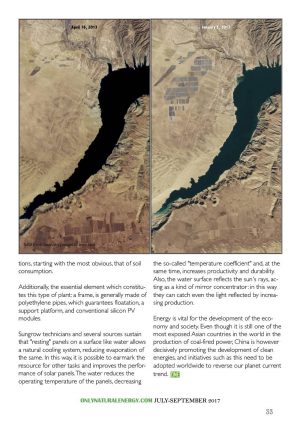 If we were convinced to have made the most of the sun’s energy, it was because we had not yet thought of turning a dismantled coal mine into a giant floating photovoltaic plant. Someone else did it: China.
If we were convinced to have made the most of the sun’s energy, it was because we had not yet thought of turning a dismantled coal mine into a giant floating photovoltaic plant. Someone else did it: China.
As usually happens when the term of coal extraction occurs, Huainan’s mining area, in southern China, has been completely flooded. In fact, after mines stop working, all drainage and water, surface and underground water drainage systems are also extinguished. As a result, pit ponds or ditch lakes are created in the open mines. From here the idea of Sungrow Power Supply, a photovoltaic inverter company, was born.
Just another record from the Chinese government, in its effort to increase renewable energy production, which transformed a mining area for coal extraction, into a floating solar plant: the largest ever built.
The 40 MW power plant, the most powerful ever made so far, was recently inaugurated, even though the record on paper remains with the 700 MW Indian floating photovoltaic project. “The plant not only re-uses the site, reducing land demand but also improves photovoltaic production thanks to the surface cooling effect,” a local government official said. The plant is already connected to the grid and supplies electricity from renewable sources to the residents of Huainan City. This is just the first of such plants in China.
It is a pure energy conversion project, which well represents the Chinese energy policy. It is moving to a gradual transition and decarbonization of energy and the abandonment of coal to prefer sources such as solar, wind and hydroelectric, that the country is investing in. This conversion to solar is helped by the collapse of the costs of the technology itself. The nation has also announced plans to increase its use of sources derived from non-fossil fuels by 20 percent.
In fact, the Longyangxia Dam Solar Park was completed in January, one of the largest in the world: 4 million solar panels cover an area of 27 square kilometers with an installed capacity of 850 MW.
A real race to photovoltaics and renewables, also demonstrated by the enormous investments of the new Chinese five-year plan: over the next three years they will invest 360 billion euros in renewable energy, to reach 110 GW of solar energy and 210 GW of wind installed. Is a solar float a good idea?
Floating solar companies are becoming very popular all over the world thanks to their unique design, which regards many problems of energy efficiency and urban planning. This design overcomes some of the drawbacks of traditional installations, starting with the most obvious, that of soil consumption.
Additionally, the essential element which constitutes this type of plant: a frame, is generally made of polyethylene pipes, which guarantees floatation, a support platform, and conventional silicon PV modules.
Sungrow technicians and several sources sustain that “resting” panels on a surface like water allows a natural cooling system, reducing evaporation of the same. In this way, it is possible to earmark the resource for other tasks and improves the performance of solar panels. The water reduces the operating temperature of the panels, decreasing the so-called “temperature coefficient” and, at the same time, increases productivity and durability. Also, the water surface reflects the sun’s rays, acting as a kind of mirror concentrator: in this way they can catch even the light reflected by increasing production.
Energy is vital for the development of the economy and society. Even though it is still one of the most exposed Asian countries in the world in the production of coal-fired power, China is however decisively promoting the development of clean energies, and initiatives such as this need to be adopted worldwide to reverse our planet current trend.
Alice Masili

